Complete Solutions to Exercise-IV of chapter WAVES of Class 11 book with complete answers and questions
| Class 11 | PHYSICS |
| Chapter | WAVES |
| NARAYANA | Exercise-IV |
| Number Of Questions | 56 |
| Academic Year | 2023-24 |
The transverse displacement `y(x, t)` of a wave on a string is given by `y(x, t)= e ^(-(ax^(2) + bt^(2) + 2sqrt((ab))xt)`. This represents a :
View SolutionA travelling wave pulse is given by
`y=(4)/(3x^(2)+48t^(2)+24xt+2)`
where x and y are in metre and t is in second. The velocity of wave is :-
View SolutionTwo sinusoidal waves are superposed. Their equations are
`y_(1)=Asin(kx-omegat+(pi)/(6))and y_(2)=Asin(kx-omegat-(pi)/(6))`
the equation of their resultant is
View SolutionA plane progressive wave is shown in the adjoining phase diagram. The wave equation of this wave, if its position is shown at `t=0`,is
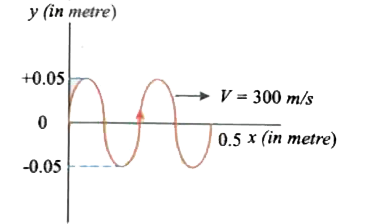
View SolutionIntensity of a point source of sound is `0.2 W/m^(2)` at a place. If the distance of source and power are doubled,the intensity at that place becomes to
View Solutionthe maximum pressure variation that the human ear can tolerate in loud sound is about `30 N //m^(2) ` . The corresponding maximum displacement for a sound wave ina air having a frequency of ` 10^(3) Hz`is
take velocity of sound in air as 300 m/s and density of air ` 1.5 kg // m ^(3)`
View SolutionA travelling wave represented by
`y=Asin (omegat-kx)`
is superimposed on another wave represented by
`y=Asin(omegat+kx).` The resultant is
View SolutionIn a sonometer wire, the tension is maintained by suspending a `20kg` mass from the free end of the wire. The fundamental frequency of vibration is `300Hz`.
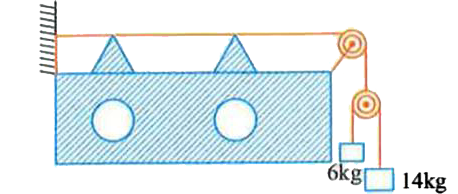
If the tension is provided by two masses of `6kg` and `14kg` suspended from a pulley as show in the figure the fundamental frequency will
View SolutionThe length of the wire shown in figure between the pulley is 1.5 m and its mass is 12.0 g. Find the frequency of vibration with which the wire vibrates in two loops leaving the middle point of the wire between the pulleys at rest.
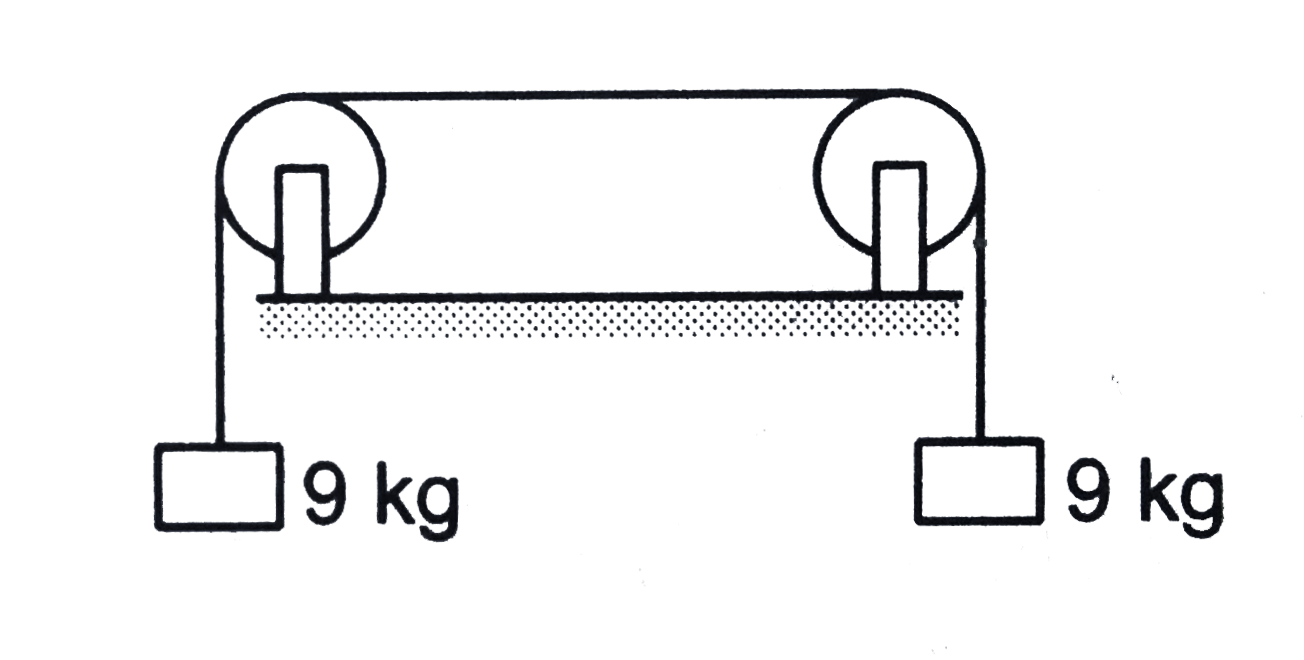
View SolutionA rod PQ of length 'L' is hung from two identical wires A and B. A block of mass 'm' is hung at point R of the rod as shown in figure. The value of 'x' so that the fundamental mode in wire A is in resonance with first overtone of B is
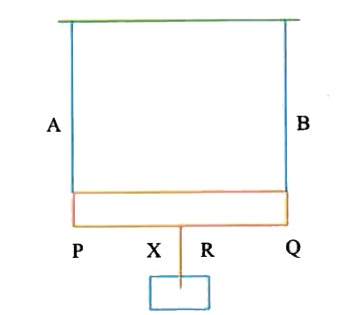
View SolutionTwo wires are fixed in a sanometer. Their tension are in the ratio `8:1` The lengths are in the ratio `36:35` The diameter are in the ratio `4:1` Densities of the materials are in the ratio `1:2` if the lower frequency in the setting is `360Hz`. The beat frequency when the two wires are sounded together is
View SolutionA string of mass M as a circular loop rotates abot its axis on a frictionless horizontal plane at a uniform rate so that the tangential plane at a uniform rate so that the tangential speed of any particle of the string is `v`. If a small transverse disturbance is produced at a point of the loop, then speed (relative to the string) of disturbance on the string is
View SolutionA stone is hung in air from a wire which is stretched over a sonometer. The bridges of the sonometer are L cm apart when the wire is in unison with a tuning fork of frequency N . When the stone is completely immersed in water, the length between the bridges is l cm for re-establishing unison, the specific gravity of the material of the stone is
View SolutionA uniform rope of mass `0.1 kg` and length `2.45 m` hangs from a ceiling.
(a) Find the speed of transverse wave in the rope at a point `0.5 m` distant from the lower end.
(b) Calculate the time taken by a transverse wave to travel the full length of the rope.
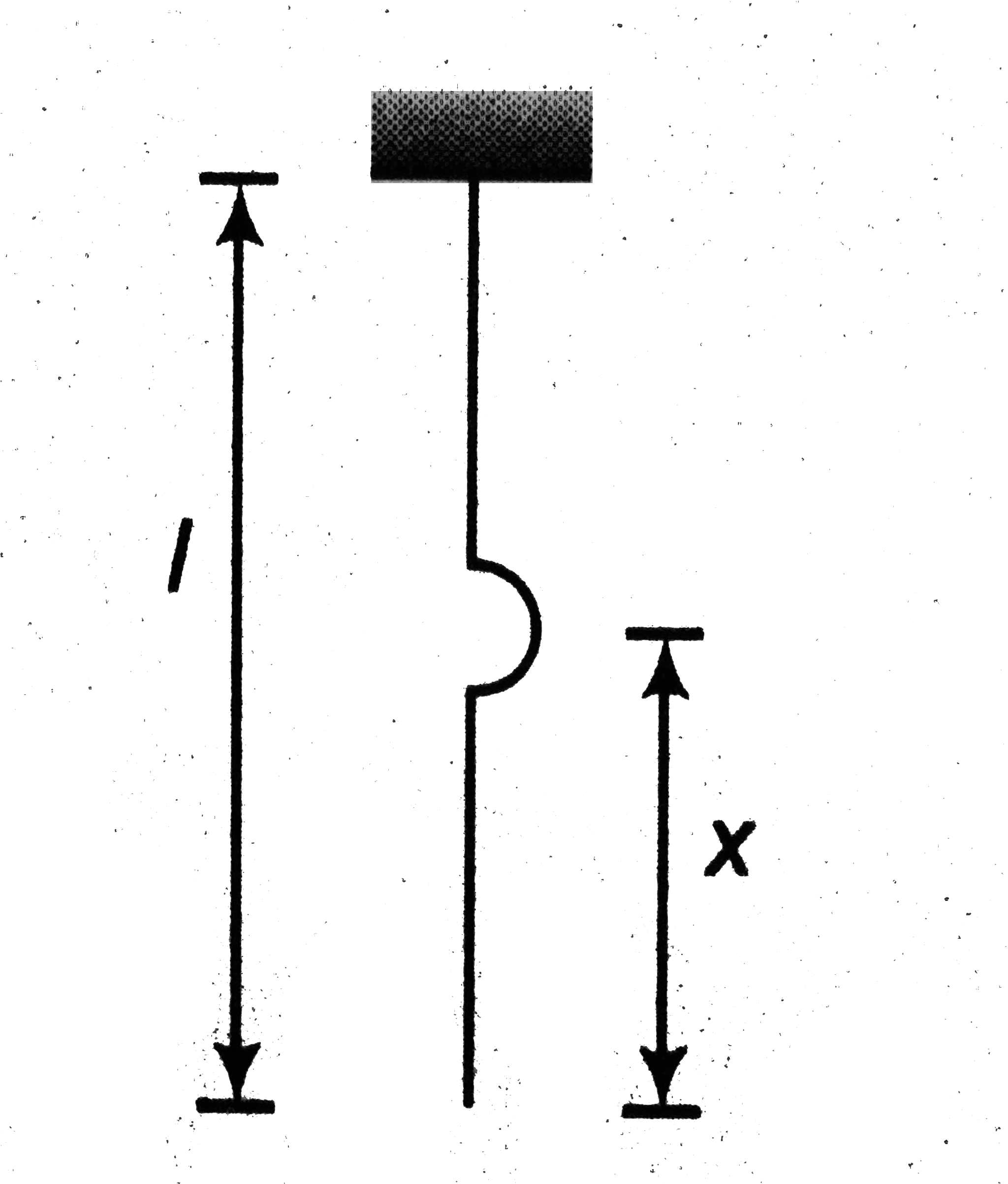
View SolutionA string of length L is stretched by `L//20` and speed transverse wave alon it is v. The speed of wave ehen it is stretched by `L//10` will be (assume that Hooke law is applicable)
View SolutionTransverse waves pass through the strings A and B attached to an object of mass 'm' as shown. If `mu` is the linear density of each of the strings, the velocity of the transverse waves produced in the strings A and B is
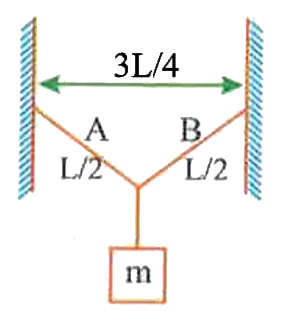
View Solutionthe fundamental frequency of a sonometer wire of length is `f_(0)`.A bridge is now introduced at a distance of `Deltal`from the centre of the wire `(Deltal lt lt l )`. The number of beats heard if their fundamental mode are
View SolutionTwo wires of radii `r` and `2 r` are welded together end to end . The combination is used as a sonometer wire and is kept under a tension `T`. The welded point lies midway between the bridges. The ratio of the number of loops formed in the wires , such that the joint is a node when the stationary waves are set up in the wire is
View SolutionThe displacement `y` of a particle executing periodic motion is given by `y = 4 cos^(2) ((1)/(2)t) sin(1000t)`
This expression may be considereed to be a result of the superposition of
View SolutionIf the two waves of the same frequency and same amplitude, on superposition produce a resultant disturbance of the same amplitude, then the phase difference between the two arriving wave will be
View SolutionThree waves of amplitudes `12mu m`, `4mu m` & `9 mu m` but of same frequency arrive at a point in a medium with a successive phase difference of `((pi)/(2))`. Then the resultant amplitude in `mu m` is
View SolutionThe ratio of the velocity of sound in Hydrogen gas `(gamma=7/5)` to that in Helium gas `(gamma=5/3)` at the same temperature is `sqrt(21/3)`.
View SolutionHow long will it take sound waves to travel a distance `l` between points A and B if the air temperature between them varies linearly from `T_1` and `T_2`? (The velocity of sound in air at temperature `T` is given by `v=alphasqrt(T)`, where `alpha` is a constant)
View SolutionA wave represented by `y=100sin(ax+bt)` is reflected from a dense plane at the origin.If `36%` of energy is lost and rest of the energy is reflected then the equation of the reflected wave will be -
View SolutionIn a stationary wave pattern that forms as a result of reflection pf waves from an obstacle the ratio of the amplitude at an antinode and a node is `beta = 1.5.` What percentage of the energy passes across the obstacle ?
View SolutionThe vibrations of a string fixed at both ends are represented by `y=16sin((pix)/(15))cos(96pit)`. Where 'x' and 'y' are in cm and 't' in seconds. Then the phase difference between the points at `x=13cm` and `x=16` in radian is
View SolutionAn open organ pipe of length `1` and fundamental frequency n is gradually dipped into water with uniform speed 'v'. The rate of change in its fundamental frequency is
View SolutionAir column of `20cm` length in a resonance tube resonates with a certain tuning fork when sounded at its upper open end. The lower end of the tube is closed and adjustable by changing the quantity of mercury filled inside the tube. The temperature of the air is `27^(@)C`. The change in length of the air column required, if the temperature falls to `7^(@)C` and the same tuning fork is again sounded at the upper open end is nearly
View Solution`AB` is a cylinder of length `1m` fitted with a thin flexible diaphragm `C` at the middle and other thin flexible diaphragms `A` and `B` at the ends. The portions `AC` and `BC` contain hydrogen and oxygen gases respectively. The diaphragms `A` and `B` are set into vibrations of same frequency. What is the minimum frequency of these vibrations for which diaphragms `C` is a node? (Under the conditions of experiment `v_(H_(2) = 1100m//s`, `v_(0_(2)` = `300m//s`).
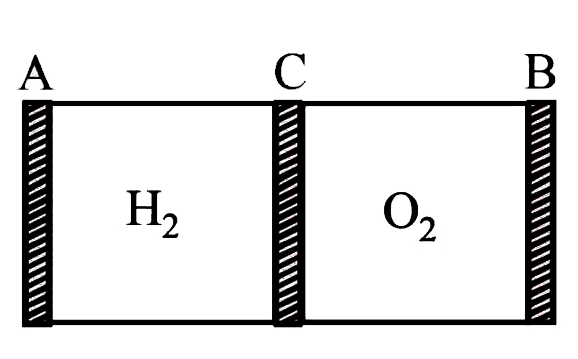
View SolutionWhile measuring the speed of sound by performing a resonance column experiment, a student gets the first resonance condition at a column length of `18 cm` during winter. Repeating the same experiment during summer, she measures the column length to be `x cm` for the second resonance. Then
View SolutionTwo tuning forks P and Q are vibrated together . The number of beats produced are represented by the straight line OA in the following graph. After loading Q with wax again these are vibrated together and the beats produced are represented by the line OB. If the frequency of P is `341Hz`, the frequency of Q will be ___________
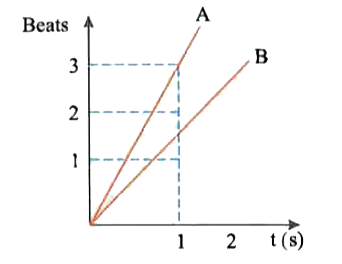
View SolutionA driver in a stationary car blows a horn which produces monochromatic sound waves of freqeuncy 1000 Hz normally towards a reflecting wall. The wall approaches the car with a speed of `3.3(m)/(s)`.
View SolutionA source of sonic oscillations with frequency `n=1700Hz` and a receiver are located on the same normal to a wall. Both the source and receiver are stationary, and the wall recedes from the source with velocity `u=6.0(m)/(s)`. Find the beat frequency registered by the receiver. The velocity of sound is `v=340(m)/(s)`.
View SolutionA motor cycle starts from rest and accelerates along a straight path at `2m//s^(2)`. At the starting point of the motor cycle there is a stationary electric siren. How far has the motor cycle gone when the driver hears the frequency of the siren at `94%` of its value when the motor cycle was at rest ? (Speed of sound = `330ms^(-2))`
View SolutionA train moves towards a stationary observer with speed 34 m/s. The train sounds a whistle and its frequency registered by the observer is `f_(1)`. If the speed of train is reduced to 17 m/s, the frequency registered is `f_(2)`. If speed fo sound is 340 m/s, then the ratio `f_(1)//f_(2)` is :
View SolutionTwo sound sources emitting sound each of wavelength `lambda` are fixed at a given distance apart. A listener moves with a velocity `u` along the line joining the two suorces. The number of beats heard by him per second is
View SolutionA source of sound is travelling with a velocity of `30(m)/(s)` towards a stationary observer. If actual frequency of source is 1000 Hz and the wind is blowing with velocity `20(m)/(s)` in a direction at `60^@C` with the direction of motion of source, then the apparent frequency heard by observer is (speed of sound is `340(m)/(s)`)
View SolutionA band playing music at a frequency `f_(0)` is moving towareds a wall at a speed `v_(0)`. A motorist is following the band with a speed `v_(m)`. If v be the speed of the sound the expression for beat frequency heard by motorist is
View SolutionA train has just completed a U-curve in a trach which is a semi circle. The engine is at the forward end of the semi circular part of the trach while the last carriage is at the rear end of the semi circular track. The driver blows a whistle of frequency 200 Hz. Velocity of sound is `340(m)/(s)`. Then the apparent frequency as observed by a passenger in the middle of the train, when the speed of the train is 30 m/s, is
View SolutionA source emitting a sound of frequency 'f' is placed at a large distacnce from an observer. The source starts moving towards the oberver with a uniform acceleration 'a'. Find frequency heard by the observer corresponding to the wave emitted just after the source starts. The speed of sound in medium is `v`
View SolutionThe waves produced by a motor boat sailing in water are :
View SolutionSound waves of wavelength `lambda` travelling in a medium with a speed of `upsilon m//s` enter into another medium where its speed is `2upsilon m//s.` Wavelength of sound waves iin the second medium is
View SolutionSpeed of sound waves in air
View SolutionChange in temperature of the medium changes
View SolutionWith the propagation of a longitudinal wave through a material medium, the quantities transmitted in the propagation direction are
View SolutionWhich of the following statements are true for wave motion? `Statement 1-`Mechanical transverse waves can propagate through all media `Statement 2-` Longitudinal waves can propagate through solids only `Statement 3-` Mechanical transverse waves can propagate through solids only `Statement 4-` Longitudinal waves can propagate through vacuum.
View SolutionA sound wave is passing through air column in the form of compression and rerefactions. In consecutive compressions and rerefactions.
View SolutionEquation of a plane progressive wave is given by `y=0.6 sin 2pi(t-(x)/(2)).` On reflection from a denser medium, its amplitude becomes `2//3` of the amplitude of the incident wave. The equation of the reflected wave is
View SolutionA string of mass 2.50kg is under a tension os 200N. The length of the stretched string is 20.0m. If the transverse jerk is struck at one end of the string, how long does the disturbance take to reach the other end?
View SolutionA transverse harmonic wave on a string is described by `y(x,t)=3.0sin(36t+0.018x+(pi)/(4))` where `x` and `y` are in cm and 't' is in sec. The positive direction of 'x' is from left to right
Which of the following are true
`(a)` the wave is travelling from right to left
`(b)` the speed of the wave is `20m//s`
`(c )` frequency of the wave is `5.7Hz`
`(d)` the least distance between two successive crests in the wave is `2.5cm`.
View SolutionThe displacement of a string is given by `y(x,t)=0.06sin(2pix//3)cos(120pit)` where x and y are in m and t in s. The lengthe of the string is 1.5m and its mass is `3.0xx10^(-2)kg.`
View Solutionv31
View SolutionDuring propagation of a plane progressive mechanical wave
Which of the following are true
`(a)` all the particles are vibrating in the same phase
`(b)` amplitude of all the particles is equal
`(c )` particles of the medium executes SHM
`(d)` wave velocity depends upon the nature of the medium
View SolutionThe transverse displacement of a string (clamped at its both ends ) is given by `y(x,t)=0.06sin(2pix//3)cos(120pit).`
All the points on the string between two consecutive nodes vibrate with
View SolutionA train, standing in a station yard, blows a whistle of frequency 400Hz in still air. The wind starts blowing in the direction from the yard to the station with a speed of 10m//s. Given that the speed sound in still air is `34om//s,
View SolutionWhich of the following statement(s) is are true for a stationary wave. I) Every particle has a fixed amplitude which is different from the amplitude of its nearest particle. II) All the particles cross their mean positions at the same time. III) There is no net transfer of energy across any plane.
View Solution
Exercise-IV questions and complete solutions for chapter WAVES of NARAYANA PHYSICS (HINGLISH) of Class 11